Review and photos by Dr Andre Mursch (“Brontodocus”). Edited by Plesiosauria.
Ichthyosaurus is one of the most iconic fossil marine reptiles, being a milestone in vertebrate paleontology since it was discovered by Mary Anning, and it was subject of a German poem about the lower Jurassic (“Der Ichthyosaurus” by Viktor von Scheffel, 1856). To compare it with shark, dolphin and sometimes tuna has become emblematic for convergent evolution as is frequently depicted in biology textbooks.
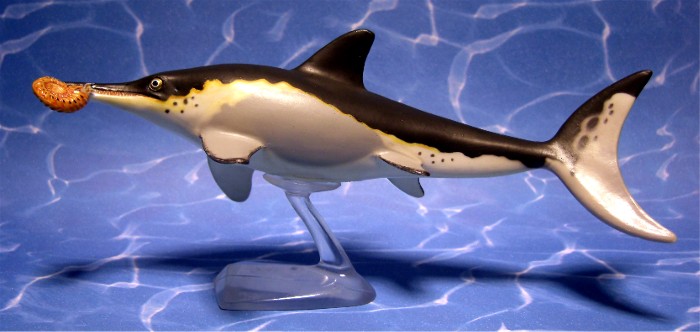
It’s neither one of the biggest nor one of the heaviest of the Carnegie figures, measuring 201 mm in direct line and weighing 86 g. If measured along the curve in an attempt to follow the position of vertebral centra in a real animal the figure would be 219 mm long. The overall body shape is robust, yet not overly massive and a lot less bulky than e.g. the Invicta Ichthyosaurus.
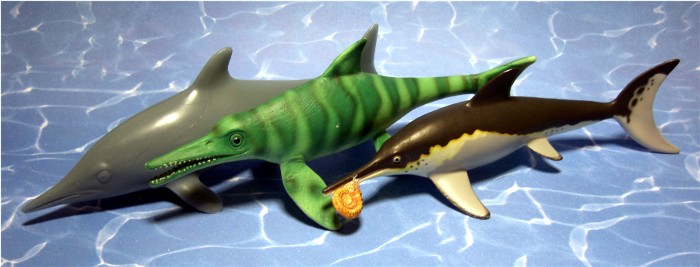
The figure’s body is gently flexed to the left side along its entire length. The front and hind flippers are broad at their bases and tapering to their tips without any constrictions at their bases (which follows reconstructions of ichthyosaur limbs by e.g. Rieß 1986). In general shape they are reminiscent of the pectoral fins of pelagic sharks. A view from below reveals that even the pectoral girdle with its muscles is traceable. The dorsal fin is quite high and also very shark-like, just like some preserved skin impressions of Stenopterygius quadriscissus show. There is a sharp tail bend of approx. 45 degrees and the longer ventral lobe of the tail fin – which would contain the vertebra in a real ichthyosaur – is thicker at its lower margin than the shorter dorsal lobe.
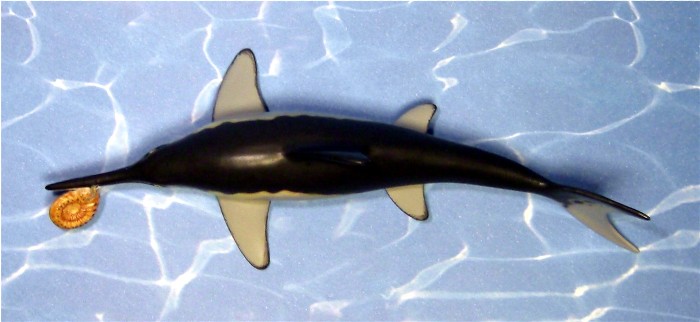
The tricolour pattern is reminiscent of that of some dolphins (e.g. Delphinus delphis) but does not copy a certain species’ colouration. The head’s upper half, the back and the tail fin’s dorsal lobe are coloured in a moderately shiny, anthracite grey. It is set off from the light grey flanks and off-white underside by an irregularly undulating margin. A narrow yellowish band separates the dark back from the lighter flanks from behind the eye to just behind the rear flippers. A few dark spots are on the sides of the neck, behind the rear flippers and on the upper lobe of the tail fin, however on the tail fin their outline is blurred on both sides. The flippers’ grey upper and off-white lower surface are separated by a dark edge that looks a little untidy and somehow does not fit too good to the allover colouration. The eyes are flawlessly painted and have a golden iris, separated from the pupil by a sharp white ring.
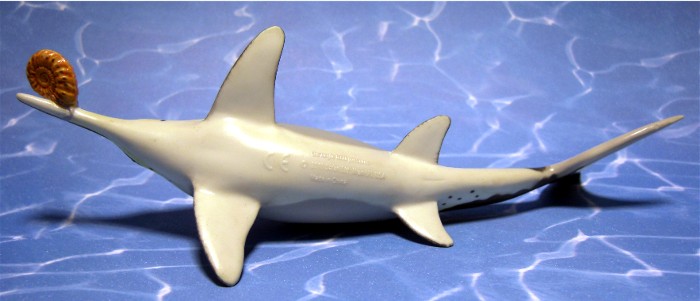
The head is wonderful in every respect. The closed jaws are more slender than usually seen in ichthyosaur figures which makes the head look quite elegant. The eyes appear relatively small, 4.5 mm in diameter, but could easily be just what was visible from a much larger eyeball inside the skull. Both the nostril and the ear are small but sharply sculpted and located a little more than an eye’s diameter before and behind the orbit, respectively, just about where one would expect them to be in the real animal. But what is really most exciting about this figure’s head is the dentition: The jaws are full of crisply sculpted teeth.
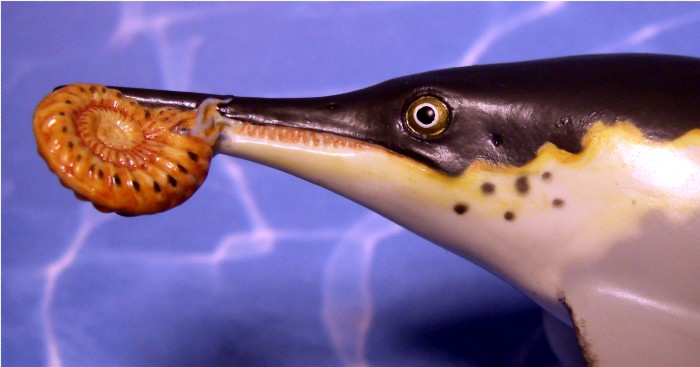
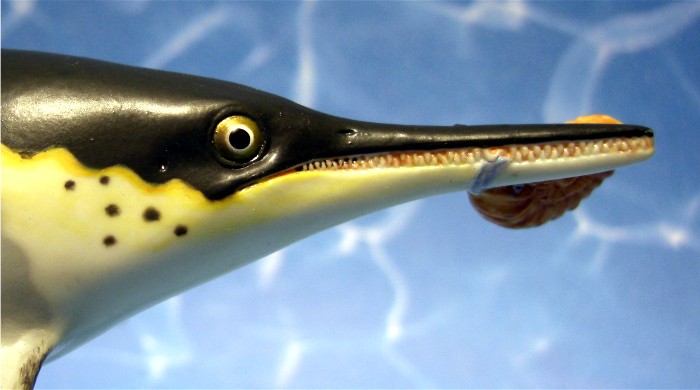
The figure’s jaws are holding an ammonite by its tentacles. This little ammonite figure – only 18 mm in diameter – is a small gem itself with shell ribs and knobs, a circumferential keel, and a dorsal head shield. Some of its arms are clutching the ichthyosaur’s jaws. However, this may reduce the playability for kids and possibilities to create groups for dioramas which would look strange when all of them have that ammonite in the same position.
One question remains: Which ichthyosaur does this figure represent? A lot of ichthyosaur renditions are actually based on Stenopterygius quadriscissus from Southern Germany, which, however, would be more or less edentulous and more thick-bodied as an adult. Generally, the different thunniform ichthyosaurs are mostly separated by quite inconspicuous details, many of them (like e.g. the number of phalanges and digits in the limbs) would only be visible in skeletons. So I had to compare the shape of the head with drawings from ichthyosaur publications (e.g. Maisch & Matzke 2000). Surprisingly, the head in fact most closely resembles that of Ichthyosaurus communis Conybeare, 1822, so the figure’s name seems appropriate. I. communis has been reported to grow to a maximum skull length of over 600 mm – compared to the 45 mm from tip of snout to ear opening this would result in a scale of approx. 1/10th to 1/14th for the figure, representing an animal of approx. 2 to 3 m length, just about what one would normally find to be stated as the length of Ichthyosaurus.
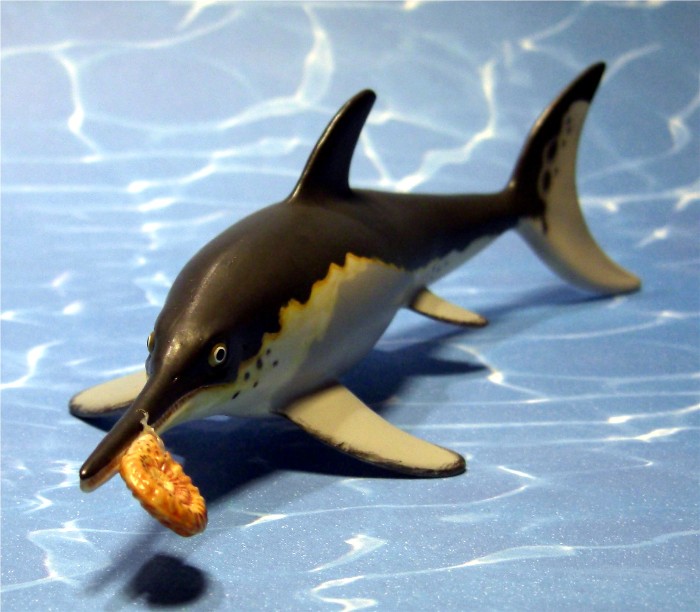
The high level of subtle detail is what makes this figure so appealing. Its elegant pose, its exquisite head that was obviously sculpted with regards to the proportions of a real specimen’s skull, its toothy jaws holding an ammonite that would not be bad as a mini figure on its own, and its vivid but not too fancy colouration emphasize that this is certainly the opposite of a sloppily made ichthyosaur figure. It is a well-considered rendition of a thunniform ichthyosaur – probably of Ichthyosaurus communis itself – instead of just a simple, somehow torpedo-shaped figure which would have equally been possible. It looks excellent from whatever angle one looks at it. The ammonite is a nice detail but probably lowers the playability of the figure as it cannot be detached (without damaging the figure) if one should prefer the ichthyosaur without it. Of course, for a collector of prehistoric figures there would be little excuse for not getting it…
Available on eBay and on Amazon.com (here)
Disclaimer: links to Ebay and Amazon on the DinoToyBlog are affiliate links, so we make a small commission if you use them. Thanks for supporting us!




[…] but its accuracy doesn’t seem too far off the mark. By no means is it detailed as nicely as the Carnegie version, and the paint application lacks finesse, but it is a strikingly good looking toy. If […]
[…] on the flippers and around the neck and shoulder region. The dorsal fin is small compared to other ichthyosaur toys, but there have been a number of paleoartistic depictions of Temnodontosaurus with such a reduced […]
Amazing figure. Simply a beautiful specimen. As for playability, my kids love it. Sure it ends up being ambushed or chased by the wild safari Liopeurodon, but that doesn’t mean it isn’t loved.
Es extraordinario por su fabuloso realismo y sobre todo por hacer el animal en el instante en que está cazando a un anmonite. Es una joya dentro de los dinosaurios de Safari y un buen coleccionista no debe dejar escapar la ocsión de comprarlo. Solo le falta hablar.
Wonderful and erudite review of an equally delightful item. It is my favorite of all the marine reptiles in my collection, largely because of the ammonite.
A while ago I thought about how the ammonite would decrease playability. Honestly, if I were a little kid I would probably end up cutting off the ammonite.
For us collectors, it is awesome though!
They really spared no attention on that ammonite, it’s gorgeous.